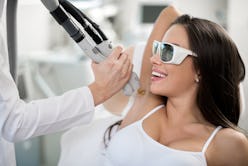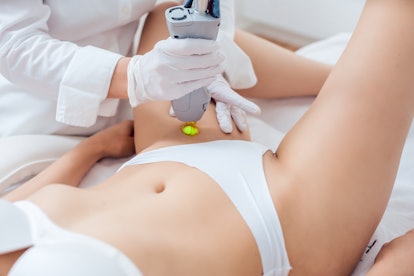Our home laser hair removal for legs is the best choice for you if you’re looking to get rid of your unwanted body hair in the comfort of your own home. You can use this device to get rid of unwanted facial hair as well, but it is not recommended for face-to-face use. The device uses the latest in laser technology to make sure that every single strand of hair is removed from your legs—and that’s what makes this product so special. It’s designed to be used on any part of the body, including arms, hands, feet and even face!
This device uses a patented “cooling system” that ensures that only the dark colored hairs are targeted by the laser pulses. This means that white or blonde hairs will not be affected by this treatment method which makes it perfect for all skin types including African American skin tones! When using our home laser hair removal device you will notice an immediate reduction in pain levels after each session because we have included cooling gel pads at strategic points around the device’s surface area where they are needed most (mainly around where contact occurs between skin and hand piece).
Read on to learn more about Best Home Laser Hair Removal For Legs Brown Skin, How Much Does Laser Hair Removal Cost? and How Long Does Laser Hair Removal Last?

Best Home Laser Hair Removal For Legs Brown Skin
Sure, spring may have just begun, but summer 2022 is only a heartbeat away, which means that many people are searching for laser hair removal options prior to the warmer season when they’ll be setting skin free by slipping into swimsuits, cut-offs, and other breezy outfits. “Our lasers have been running around the clock since the day we re-opened and show no signs of slowing down,” says Dr. Corey L. Hartman, a board-certified dermatologist and the founder of Skin Wellness Dermatology in Birmingham, Alabama.
Laser hair removal treatments are undoubtedly an investment in terms of both time and money, but Dr. Kavita Mariwalla, a board-certified dermatologist based in West Islip, New York, tells TZR that the last two years only piqued more patients’ interest. “[2021] showed people that life is worth living…sometimes spending it on yourself is okay and not something to feel guilty about,” she says. And if living your best life entails dolphin-smooth skin that isn’t subject to stubble, ingrowns, or razor burn, you may want to consider signing up — stat.
“On average it takes at least six to eight months to reach desired results, so it’s best to start sooner than later!” says Samantha Pang, an aesthetic nurse practitioner at SkinSpirit in Beverly Hills, California. Whether you’re a newbie or ready to make your return to the world of laser hair removal after months of social distancing, find out all the facts before you get this long-awaited party started.
How Does Laser Hair Removal Work?
“While both laser and IPL can be used to heat hair follicles and prevent regrowth, the technology behind each is very different,” says Dr. Hartman. A laser treatment “affects hair in the active growth phase” and uses “controlled pulses of energy that target the pigment in the hair follicle,” he says. “IPL is not a laser at all. Instead, it is a scattered light device that delivers energy of different wavelengths to treat blood vessels, brown spots, and hair removal.” All of the derms TZR tapped for this piece typically opt for lasers over IPL when it comes to permanent hair reduction. “Generally speaking, IPL is not considered as effective as lasers when it comes to hair removal,” says Dr. Mariwalla. Instead, many dermatologists, like Dr. Hartman, use IPL as a “magic eraser” to treat photodamage in lighter skin tones.
Who Is A Good Candidate For Laser Hair Removal?
Dark, coarse hair is optimal, but Dr. Mona Gohara, a board-certified dermatologist in Hamden, Connecticut, says that laser technology has come a long way since its inception in the 1960s. “In 2021, I can confidently say that there is a laser for every skin type,” she notes. However, because most devices are attracted to melanin at the root of the hair follicle, people with blonde, gray, or red hair may not experience success. “Keep in mind, just because someone has [gray], blonde, or red hair on their head doesn’t always mean it is the same throughout their entire body,” adds Dr. Mariwalla, who recommends booking a professional consultation if you’re unsure.
Other important factors to remember: laser hair removal is not a “one-and-done situation,” says Dr. Gohara, who emphasizes that the ideal patient is “motivated to stick with it” for all of the sessions it will require to remove the hair permanently (more on that later).
What Is The Best Type Of Laser Hair Removal For Melanin-Rich Skin?
“The wavelength is the key factor here and not really the manufacturer,” explains Dr. Mariwalla, who says a device with a longer wavelength (such as a 1064 nanometer laser) penetrates deeper and targets the melanin at the root of the hair follicle. Dr. Hartman’s must-haves include the Nd:YAG laser (1064 nanometers) for melanin-rich skin and the Alexandrite laser (755 nanometers) for lighter complexions. Both Dr. Hartman and Dr. Mariwalla use the Candela GentleMax Pro in their practices because it houses both of the aforementioned lasers and can be used on a wide variety of patients.
It’s important to note that even the correct wavelength in the wrong hands can still cause discoloration and burns. “Don’t be afraid to ask what type of laser is being used, as well as who is administering the laser and if that person has experience with melanin-rich skin,” emphasizes Dr. Gohara, who says seeking out a board-certified dermatologist or a registered nurse with a well-established track record is paramount.
Does Laser Hair Removal Hurt?
“I think it’s less painful than a Brazilian wax,” argues Dr. Gohara, who likens laser hair removal to a rubber band being gently snapped across the skin. If you’re especially sensitive, she recommends applying LMX 4 (a topical anesthetic available over the counter) 30 minutes prior to treatment and a cortisone cream immediately after to settle any inflammation. “In my office, we ice the treated area to cool it down and apply a barrier cream and sunscreen before sending a patient out the door,” she adds. Hartman says that most devices also incorporate a cooling system to minimize discomfort during the procedure, and “spot sizes” (i.e., the area a laser can treat in a single pulse) have grown over time to speed up the de-fuzzing process.
How Do I Prep For Laser Hair Removal?
It’s always important to avoid harsh rays (and avoid tanning beds!), but it’s especially crucial to minimize sun exposure six weeks prior to laser hair removal. “The pigment in the hair follicle targeted by the laser is similar to the pigment present when the skin is tan and could be damaged during the procedure,” warns Dr. Mariwalla.
To avoid irritation, Dr. Hartman also recommends discontinuing the use of any topical products containing ingredients that cause photosensitivity — like hydroxy acids, salicylic acid, retinol, and benzoyl peroxide — in the treatment area at least three days prior to a session. On the day of the appointment, arrive with clean skin free of lotion, self-tanner, fragrance, or deodorant (if you are treating underarms), and shave no earlier than 24 hours in advance. Other forms of temporary hair removal are also a no before treatment. “Since the laser targets the root of the hair, you cannot wax, tweeze [epilate, sugar, or use chemical depilatories] between laser sessions or three weeks prior to treatment, otherwise, it disrupts the hair removal process,” adds Dr. Mariwalla.
Laser Hair Removal After-Care
A broad-spectrum sunscreen with at least an SPF of 30 is always a daily essential regardless of skin tone, but it’s especially important following laser hair removal. Dr. Mariwalla recommends avoiding sun exposure for two weeks after a treatment, as it can cause hyperpigmentation, burns, and scarring. Since that skin is already sensitive, Dr. Gohara also suggests eliminating harsh actives (like the ones Dr. Hartman outlined above) and applying a barrier cream like Vaseline or First Aid Beauty Ultra Repair BarriAIR Cream to hydrate, soothe, and repair.
How Long Does Laser Hair Removal Last?
Laser hair removal is a “true lunchtime procedure,” says Dr. Hartman, who notes that the average treatment can take as little as ten minutes (for a small area like underarms) or up to 45 minutes for the back or legs. Keep in mind, however, that laser hair removal is a marathon — not a sprint. While the number of sessions required is unique to each patient, their hair type, and the zone being targeted, it can range anywhere from four to ten treatments (typically performed four to six weeks apart) to permanently reduce hair by 80%.
“Hair that does return will generally be thinner, slow-growing, and less pigmented,” says Dr. Mariwalla. Most derms recommend yearly touch-ups, but you may want to consider a booster every six months or even once a quarter to maintain the results, adds Dr. Gohara.

How Much Does Laser Hair Removal Cost?
“Costs for laser hair removal vary according to the area of the body that is being treated, your geographical location, the expertise of the person performing the procedure, and amount of time it takes,” explains Dr. Hartman, who says an individual session generally falls somewhere between $100 to $500. Some clinics even offer package deals, like SkinSpirit, which has locations in California, Texas, Utah, and Washington. “The most popular laser hair removal treatments are the Brazilian [bikini area] and underarms,” says Pang. She recommends a package of eight treatments, which will set you back $1400 for a Brazilian and $930 for underarms at SkinSpirit in Beverly Hills. “It’s an upfront investment, but there are long-term benefits,” says Dr. Gohara. “For a lot of people who struggle with [unwanted] hair, [laser treatments] are worth their weight in gold.”
Does Laser Hair Removal At Home Work?
DIY devices unfortunately don’t provide the same level of power as the machines you’d find in a professional office setting and thus deliver less reduction in hair. They are also designed primarily for those with lighter skin tones and dark hair, so if you fall outside of those parameters it’s probably best to see a pro. Dr. Gohara recommends the SmoothSkin Pure (an at-home IPL machine) and the Tria Hair Removal Laser 4X, both of which feature a built-in sensor that prevents the device from firing if it deems the treatment area unsafe.